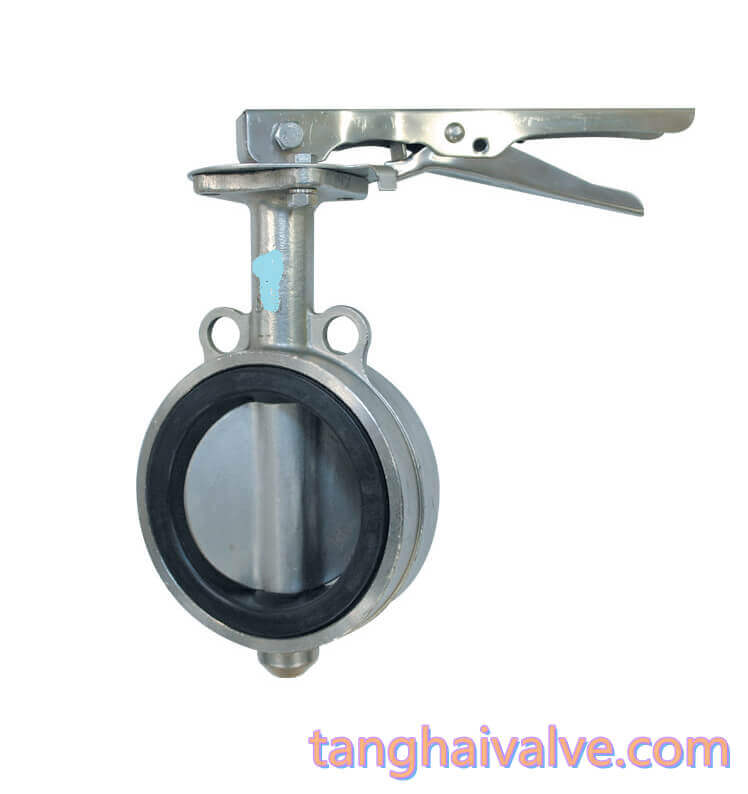Introduction to the Characteristics and Uses of Centerline Wafer Butterfly Valves
Features of centerline wafer butterfly valve:
The centerline wafer butterfly valve can be divided into two categories according to the purpose and structure: sealed butterfly valve and non-sealed butterfly valve. Before understanding these two butterfly valve products, we need to have a general understanding of the characteristics of the butterfly valve.

JIS 10K-wafer butterfly valve-backup seat (4)
The name of the butterfly valve comes from the butterfly plate of the wing-like structure. Its operation mode is that the butterfly plate rotates 90° around the axis of the butterfly plate or the axis outside the butterfly plate in the cylindrical channel of the butterfly valve body to complete the opening and closing of the butterfly valve. The purpose of the midline wafer butterfly valve is to cut off and adjust in general industries such as petroleum, chemical industry, urban gas, urban heating, water treatment, etc. It is also used in the condenser and cooling water system of thermal power plants.
The sealing pair of the centerline wafer butterfly valve can be made of elastic materials such as rubber and fluoroplastic, and the soft seal butterfly valve is usually of the centerline type. For elastic sealing, the sealing ring can be embedded in the channel of the butterfly valve body or in the periphery of the butterfly plate. When used as a shut-off valve, the sealing performance of the soft-sealed midline butterfly valve can reach FCI70-2; 2006 (ASME B16-104) level VI, which is much better than the metal sealing pair. However, the soft-sealed midline wafer butterfly valve has a limitation, that is, the valve is not resistant to high temperature due to the influence of the material of the sealing pair, and there is a limit to the operating temperature.
Sealed centerline wafer butterfly valve and non-sealed centerline wafer butterfly valve:
1. Sealed midline wafer butterfly valve, this kind of butterfly valve can ensure complete sealing when closed, and can be used for cutting off in the pipeline. Seals are usually made of rubber and fluoroplastics. However, the eccentric metal-sealed butterfly valve and the blue-free butterfly valve that appear now can also achieve good sealing and two-way sealing.
2. The non-sealed midline wafer butterfly valve cannot guarantee absolute sealing when it is closed, but the leakage should still meet the ISO standard B, C, D grades, or meet FCI 70-2; 2006 (ASME B16.104) Class II,III,IV,V, this kind of butterfly valve is only suitable for use in pipelines for regulation or in pipelines with lax sealing requirements. The sealing material is usually metal.
The body form of the centerline wafer butterfly valve can be single flange type, no flange type or U-shaped section type. In the future, the technology of butterfly valve will also adapt to large diameter, high pressure and wide temperature range, so that the technology of butterfly valve will reach a higher level.
TH Valve is a professional manufacturer of butterfly valve, gate valve, check valve, globe valve, knife gate valve, ball valve with API, JIS, DIN standard, used in Oil, Gas, Marine industry, Water supply and drainage, fire fighting, shipbuilding, water treatment and other systems, with Nominal Diameter of DN50 to DN1200, NBR/EPDM/VITON, Certificates & Approvals: DNV-GL, Lloyds, DNV, BV, API, ABS, CCS. Standards: EN 593, API609, API6D
Video of center-lined butterfly valve:
Related news/knowledge:
Characteristics of the centerline wafer butterfly valve
Centerline flange butterfly valve
Advantages and Features of Center-lined Wafer Butterfly Valve
Commonly used valve body materials of centerline wafer butterfly valve



 © Copyright 2020 Tianjin Tanghaidongyang Valve Co., Ltd. All Rights Reserved.
© Copyright 2020 Tianjin Tanghaidongyang Valve Co., Ltd. All Rights Reserved.